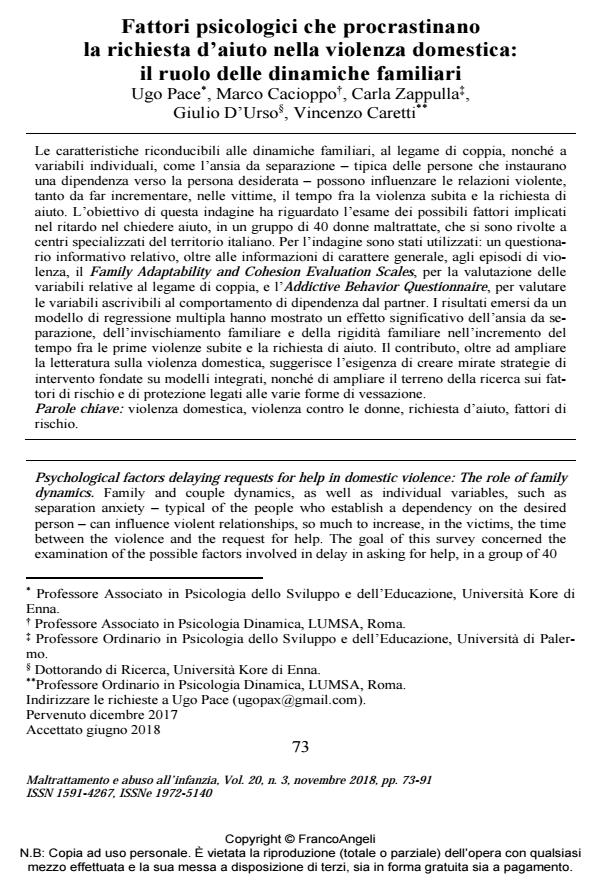Psychological factors delaying requests for help in domestic violence: The role of family dynamics.
Journal title MALTRATTAMENTO E ABUSO ALL’INFANZIA
Author/s Ugo Pace, Marco Cacioppo, Carla Zappulla, Giulio D’Urso, Vincenzo Caretti
Publishing Year 2018 Issue 2018/3
Language Italian Pages 19 P. 73-91 File size 243 KB
DOI 10.3280/MAL2018-003005
DOI is like a bar code for intellectual property: to have more infomation
click here
Below, you can see the article first page
If you want to buy this article in PDF format, you can do it, following the instructions to buy download credits

FrancoAngeli is member of Publishers International Linking Association, Inc (PILA), a not-for-profit association which run the CrossRef service enabling links to and from online scholarly content.
Psychological factors delaying requests for help in domestic violence: The role of family dynamics. Family and couple dynamics, as well as individual variables, such as separation anxiety - typical of the people who establish a dependency on the desired person - can influence violent relationships, so much to increase, in the victims, the time between the violence and the request for help. The goal of this survey concerned the examination of the possible factors involved in delay in asking for help, in a group of 40 abused women who turned to specialized centers of the Italian territory. Participants were administered the Family Adaptability and Cohesion Evaluation Scales, for the evaluation of the variables related to the couple bond, and the Addictive Behavior Questionnaire, to evaluate the variables ascribable to the behavior of dependence on the partner. In addition, information about the episodes of violence were collected. The results from the multiple regression model showed a significant effect of anxiety from separation, family entanglement and family rigidity in increasing the time between the first violence and the request for help. The contribution, in addition to expanding the literature on domestic violence, suggests the need to create targeted strategies of intervention based on integrated models, as well as expanding the field of research into risk and protection factors related to the various forms of harassment.
Keywords: Domestic violence, violence against women, help request, risk factors.
- IPV and prematurity: What does literature say? Chiara Ionio, Eleonora Mascheroni, Giulia Segre, in MALTRATTAMENTO E ABUSO ALL'INFANZIA 1/2020 pp.67
DOI: 10.3280/MAL2020-001006 - Violenza domestica al tempo del Covid-19 Sara Rizzi, in WELFARE E ERGONOMIA 2/2021 pp.155
DOI: 10.3280/WE2020-002011
Ugo Pace, Marco Cacioppo, Carla Zappulla, Giulio D’Urso, Vincenzo Caretti, Fattori psicologici che procrastinano la richiesta d’aiuto nella violenza domestica: il ruolo delle dinamiche familiari in "MALTRATTAMENTO E ABUSO ALL’INFANZIA" 3/2018, pp 73-91, DOI: 10.3280/MAL2018-003005